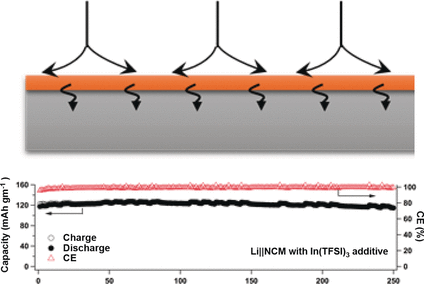Hybrid indium–lithium anodes provide fast interfacial ion transport

Novel lithium electrodes coated with indium could be the basis for more powerful, longer-lasting, rechargeable batteries. The coating hinders undesirable side-reactions between the electrode and electrolyte, provide a more uniform deposition of lithium when charging, and augments storage in the lithium anode via alloying reactions between lithium and indium, as reported by American scientists in the journal Angewandte Chemie. Their success stems from the good diffusion of lithium ions along the interfacial layer.
Modern lithium ion batteries usually have graphite anodes that store lithium when the batteries are charged. An interesting alternative is presented by batteries with metallic anodes, such as lithium metal, which promise significantly higher storage capacity. However, a significant hurdle barring their successful implementation has been the uneven deposition of the metal during the charging process, which leads to formation of dendrites. After longer uses of the battery, these dendrites can grow so extensive that they short-circuit the battery. In addition, there are undesirable side-reactions between the reactive metal electrodes and the electrolyte, which significantly reduces the lifetime of the batteries. The formation of a stable, passivating layer that prevents further contact would be an ideal solution; however, it isn't possible because of the constant expansion and contraction of the electrode upon charging and discharging. This destroys the layer and exposes the metal to the electrolyte for more reactions. Other approaches include artificial films or physical barriers.
Researchers working with Ravishankar Sundararaman at Rensselaer Polytechnic Institute (Troy, USA) and Lynden A. Archer at Cornell University have now introduced a novel alternative. By using straightforward electroless ion-exchange chemistry, they produced indium coatings on lithium. Simple immersion in a special indium salt solution is all it takes. Some of the indium is deposited on the surface of the lithium electrode as metal and the lithium ion concentration in the electrolyte simultaneously increases.
The indium layer is uniform and self-healing when the electrode is in use, if small amounts of the indium salt are added to the electrolyte. It remains intact during charge/discharge cycles, its chemical composition remains unchanged, and side-reactions are prevented. Dendrites are also eliminated, leaving the surface smooth and compact.
By using computer modeling, the researchers were able to show why their method is so successful: lithium ions are very loosely bound to the indium coating. They form an alloy with the indium, which allows them to move very rapidly over the surface before they cross it and are deposited on the underlying lithium electrode. In complete cells with commercial cathodes, these new indium–lithium hybrid electrodes were stable over more than 250 cycles, retaining about 90 % of their capacity.
More information: Snehashis Choudhury et al. Electroless Formation of Hybrid Lithium Anodes for Fast Interfacial Ion Transport, Angewandte Chemie International Edition (2017). DOI: 10.1002/anie.201707754
Journal information: Angewandte Chemie , Angewandte Chemie International Edition
Provided by Wiley



















